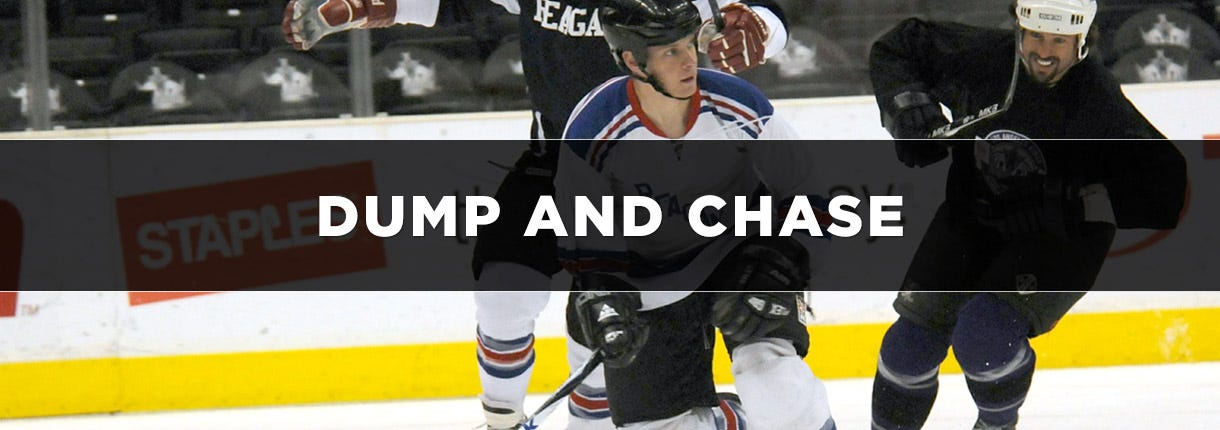Dump and Chase: What is It, and How Do You Use it in Hockey?

The Dump and Chase in ice hockey is when the puck-possessing team crosses the red line and dumps the puck deep into the opposing teams’ zone. Doing so will allow your speedy wingers to chase down the puck and catch opposing defensemen off-guard. The potential result could be the possession of the puck for your team, leading to a scoring opportunity. While puck possession is key in the game of ice hockey, the dump and chase method is generally seen as a safer play (compared to skating it in), due to a lesser chance of turning the puck over in the neutral zone.
Due to it being the “safer” option, the dump and chase method is taught to players at a young age and is effectively utilized throughout all skill levels of ice hockey, including the NHL. However, there are a few pros and cons to the dump and chase method, which will be discussed in this article, along with a few alternatives that are commonly seen. Visit our website to check out our vast selection of hockey skates!
- When Should You Use the Dump and Chase?
- Using the Dump and Chase Effectively
- In-Game Examples of the Dump and Chase
- Dump and Chase in the NHL
- Dump and Chase vs. Carrying the Puck
When Should You Use the Dump and Chase?
Teams will often use the dump and chase method if they know they have a mismatch, meaning speedy wingers against a defensive pairing that is significantly slower. This could lead to puck possession for your team. Additionally, this can also be used simply for a line change to get fresh players out onto the ice from the bench.
Using the Dump and Chase Effectively
The section below will have a few tips, and things to keep in mind, in order to help teams effectively utilize the dump and chase method.
Tip 1: Make Defenders Move
The primary objective for a defenseman is to prevent the team with the puck from scoring on their net. So, when the puck possessing team is skating through the neutral zone, the defensemen will often time step up and prevent them from taking it into their defensive zone. This is where the dump and chase comes in.
When a team dumps the puck into the offensive zone, and skates after it, most of the time defensemen will have to turn around and skate forward to keep up with the speed of forechecking wingers. The split second that it takes for the defenseman to go from back skating to forward skating could be just enough time for the wingers to gain possession of the puck.
Tip 2: Think Quickly
If you are the player that is the one dumping it into the zone, you have three options, and one will have to be made within a matter of seconds Send the puck around the goal, so it goes around the boards behind the net to your opposite-side winger, dump it high into the corner and let your wingers go get it, or dump it in and chase it yourself.
Sending it around the boards behind the net is a great option if the three offensive forwards are speedy and can all get in the play quickly. This method can lead to a lot of three (offensive players) versus two (defensemen) situations. Dumping the puck into the corner and letting a quick winger chase it is effective because more often times than not the defenseman will have to transition from a backskate to a forward skate to match the speed of the oncoming winger, leaving him out of position. Another option is to dump the puck into the corner and go get it yourself. If you are a quick winger and notice that the defensemen are out of position, meaning they are too close to you, you can dump it in, and use your speed to beat them to the puck.
Tip 3: Forecheck Hard
The primary reason why some teams do not use the dump and chase method is because they do not like the idea of intentionally “turning the puck over”. If a team dumps the puck in and the defending team comes up with it, it will be considered a turnover.
Therefore, it is especially crucial for the team dumping the puck to forecheck hard and retrieve the puck before the opposing defensemen do. This will also often time include battling for it in the corners, which is why some teams will send bigger wingers for this specific task. If the dumping team does not retrieve the puck it could easily lead to a fast break for what was previously the defending team, due to the attacking team having all three forwards still in the offensive zone.
In-Game Examples of the Dump and Chase
In the video below, the Washington Capitals defenseman is seen firing the puck deep into the other team’s zone. From there, the right-winger for the Capitals outraces the opposing defender to the puck in the corner. Right at the 24-second mark, you can see that the defender has to turn from a back skate to a forward skate, which buys the Capitals winger just enough time to blow by him and beat him to the puck. Once the right-winger gains possession of the puck, the Capitals left winger cuts to the net for a pass and a shot on net.
This play was advantageous for the Capitals for a few reasons. They were able to maintain possession of the puck even after the dump in, thanks to a hard forecheck, they were able to get two good shots on net, and lastly, they were able to get back on defense in time to prevent a fast break going the other way.
Dump and Chase in the NHL
As mentioned earlier, some teams in the NHL will incorporate the dump and chase method into their game plan more than others. Teams that favor it usually have a quicker overall roster compared to the teams that prefer to avoid it.
| Rank | Team | Dump In % (Neutral Strength) |
|---|---|---|
| 1 | Islanders | 55.6% |
| 2 | Canucks | 55.2% |
| 3 | Wild | 55.0% |
| 4 | Devils | 54.1% |
| 5 | Blues | 53.6% |
The list above shows the NHL teams that use the dump and chase method the most. As of February 2019, the Islanders sit atop this list, utilizing the dump and chase on 55.6% of their offensive-zone entries. As a result, the Islanders have one of the lowest neutral-zone turnover rates in the league at just 8.9%.
Further studies show that there is a direct correlation between the dump and chase method and a lower neutral-zone turnover rate. However, of course, it does have its pros and cons which takes us to the next section of this article.
Dump and Chase vs. Carrying the Puck
The two most common methods of getting the puck into the offensive zone (zone entry) is dumping and chasing and skating it into the zone, also known as a “controlled entry”. As alluded to earlier, both have their pros and cons and it usually comes down to the style of the team’s play to determine which one is used more frequently. That said, let’s compare the two by looking at their advantages and disadvantages.
The Dump and Chase method can be especially effective for teams who have speedy wingers that have the ability to outskate opposing defensemen. This will also be especially effective if a defending team has slower skating defensemen. As a downside, there is always a chance that the puck could be turned over, meaning the defending team gains possession of it. This is the main argument against this method, as a lot of teams do not like the idea of “intentionally” giving up possession of the puck (from dumping it into the zone). If the defending team gains possession after a dump and chase, it could quickly lead to a fast break going the other way.
On the contrary, Carrying the Puck into the zone, also known as a controlled entry, is more of a “high-risk, high- reward” play. This is great for teams who have a guy with great speed and stickhandling skills. Teams like the Edmonton Oilers and Colorado Avalanche are great at getting the puck from the neutral zone into the offensive zone thanks to guys like Connor McDavid and Nathan MacKinnon. These guys can get the puck into the offensive zone, and rarely lose possession of it, allowing for great scoring opportunities. The downside here is that skating it into the offensive zone does not work 100% of the time. There are occasionally turnovers in the neutral zone, which is something to always keep in mind as a potential occurrence when a player is skating through this zone with the puck.
A general rule of thumb is for teams to utilize a little bit of both of these methods into their game plan. This will keep opposing teams guessing, instead of them getting used to one style of play and shutting it down.









Login and Registration Form
or
Create an account